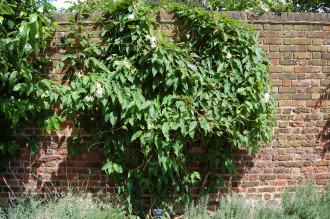
Mandevilla laxa (18/07/2015, Kew Gardens, London)
Position: Full sun
Flowering period: Late summer
Soil: Moist, well drained
Eventual Height: 5m
Eventual Spread: 4m
Hardiness: 8a, 8b, 9a, 9b, 10a, 10b, 11
Family: Apocynaceae
Mandevilla laxa is a semi-evergreen (deciduous in the cooler part of its range) climber with woody structure and a spreading habit. Its glossy mid green leaves are ovate with entire margins, to to 15cm long and 4cm wide. Its fragrant white flowers are trumpet shaped, up to 7cm across, 5cm long and appear on current year’s growth. Its fruit are bean like pods which are initially green, mature brown and split to disperse its seeds.

Mandevilla laxa Flower (18/07/2015, Kew Gardens, London)
Mandevilla laxa, commonly known as Chilean Jasmine, is native to Argentina, Peru, Ecuador and Bolivia.
The etymological root of the binomial name Mandevilla is named after Henry Mandeville (1773 – 1861), a British diplomat and gardener based in Argentina. Laxa is derived from the Latin laxo meaning ‘loose’.
The landscape architect may find Mandevilla laxa useful as an attractive evergreen climber with fragrant flowers. This plant requires a framework against which to climb.

Mandevilla laxa Leaf (18/07/2015, Kew Gardens, London)
Ecologically, Mandevilla laxa flowers are attractive to pollinating insects, including bee and butterflies.
The Royal Horticultural Society has given Mandevilla laxa their prestigious Award of Garden Merit in 2002.
Mandevilla laxa prefers moist, fertile, well-drained soils. It tolerates most pH of soil.
Mandevilla laxa requires little maintenance. Pruning may be carried out in spring to encourage new growth.

Landscape Architecture

